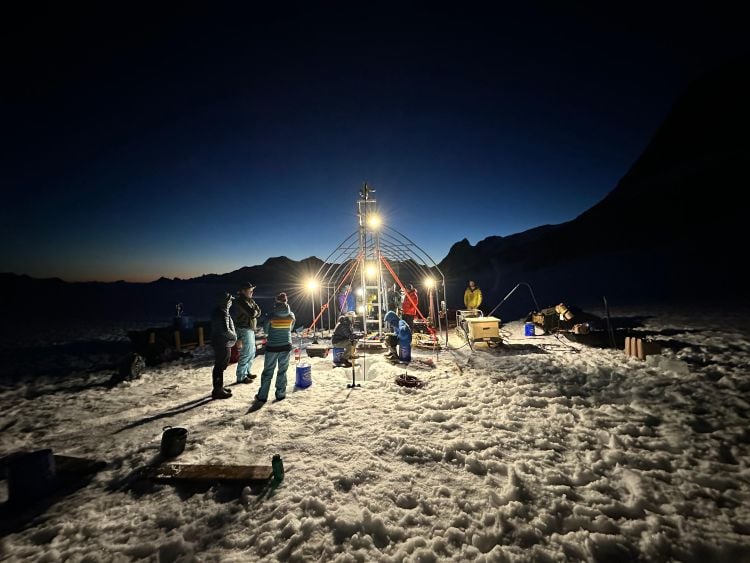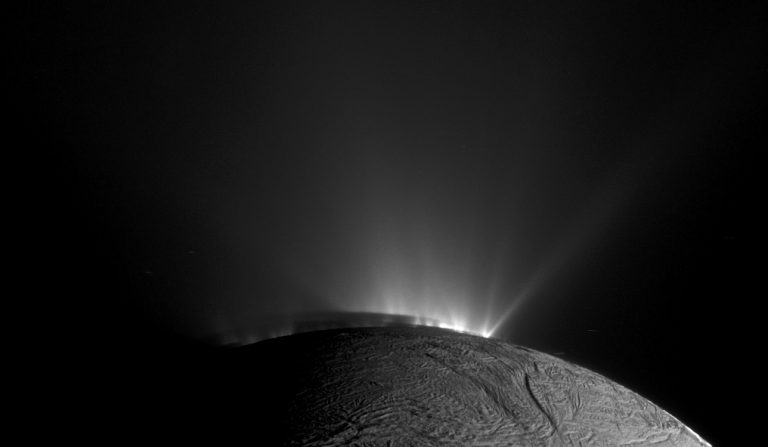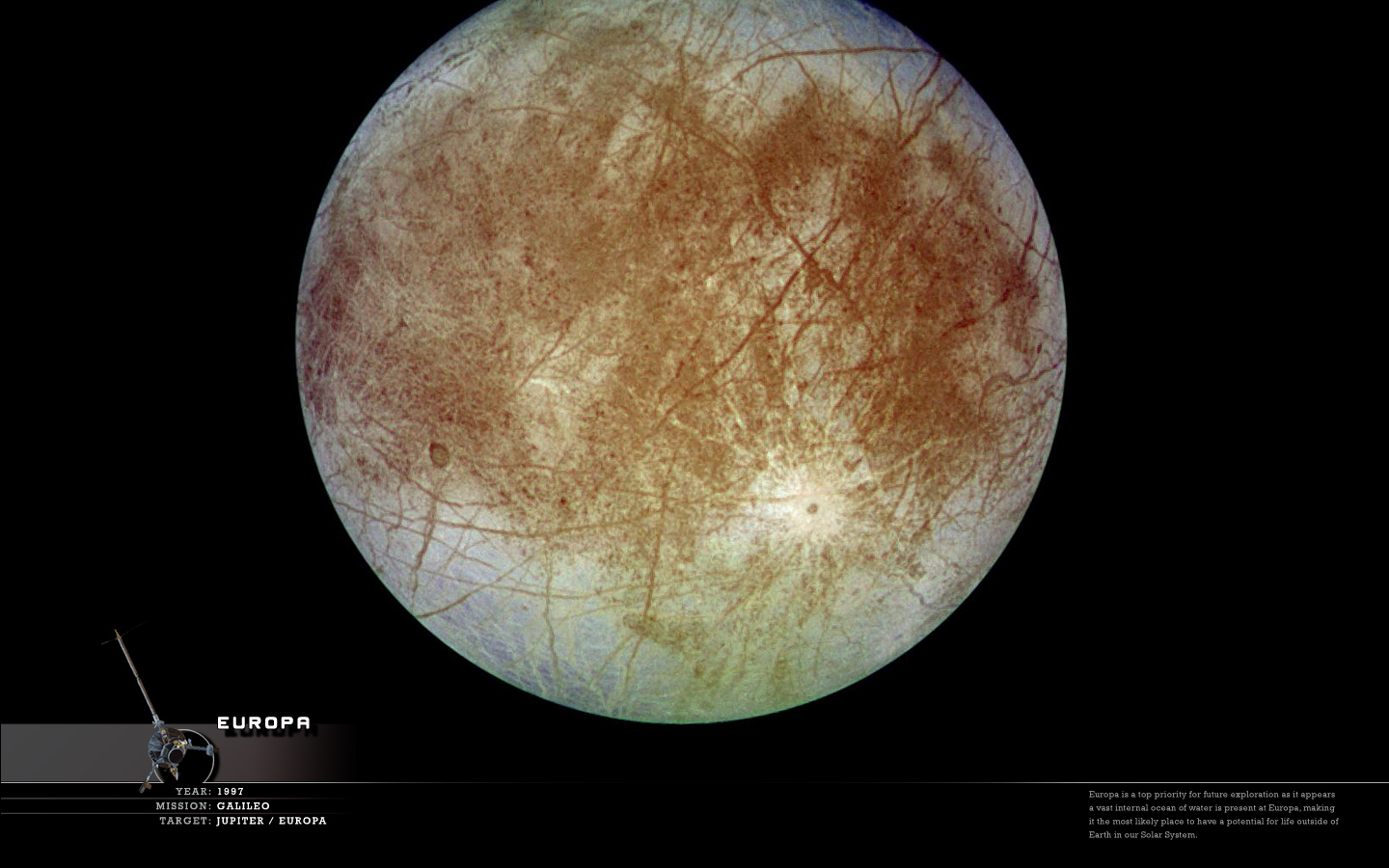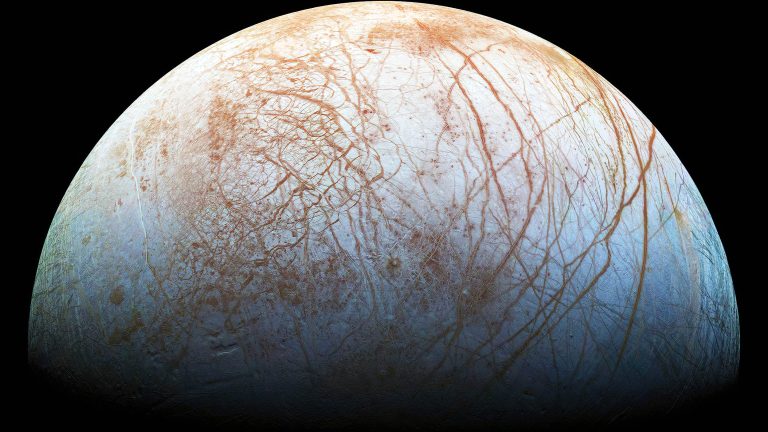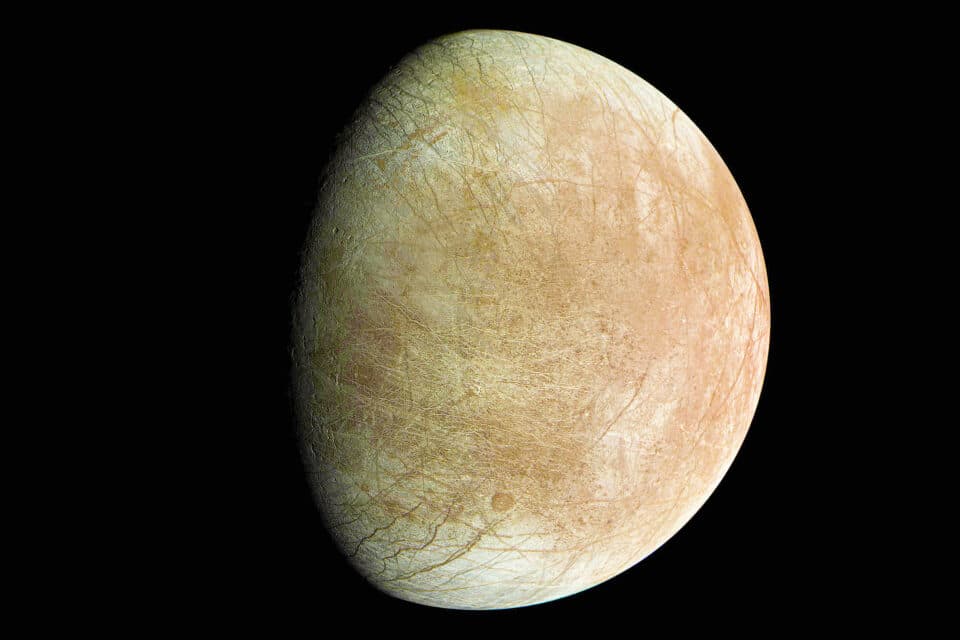Exploring Europa and Distant Ocean Worlds Using ORCAA Cryobots
The ORCAA (Ocean Worlds Reconnaissance and Characterization of Astrobiological Analogs) project is helping scientists explore how robotic probes called cryobots could drill through the icy crusts of distant ocean worlds like Europa. By simulating real-world environments here on Earth, especially in icy regions like Alaska, researchers are testing how future missions might search for signs of life below the surface of Europa and other moons in our solar system. This work supports missions like NASA’s Europa Clipper and lays the groundwork for future deep-ice exploration.
Summary
- The ORCAA project is part of NASA’s effort to explore icy moons that may hold liquid oceans beneath their frozen surfaces.
- Scientists used Alaska’s Echo Glacier in 2023 to test a hot water drill for future missions to Europa.
- Small amounts of ATP (a molecule used for cell energy) and CHLa (linked to photosynthesis) were found, showing possible life indicators.
- A new field test is planned for 2025 at North Basin with an actual cryobot instead of a hot water drill.
- Cryobots are robotic probes that can melt through thick ice and collect samples from hidden oceans.
- These tests aim to improve the robot’s ability to operate on its own and make decisions during a mission far from Earth.
- The study helps prepare for future missions that may drill through Europa’s crust to explore its ocean for signs of life.
- The Europa Clipper mission, launching toward Europa, will orbit the moon 49 times starting in April 2030.
- It will avoid Jupiter’s radiation belts by using elliptical orbits and find the best spots to drill in future missions.
- A future Europa Lander might look for signs of life on Europa’s surface and test new tools for drilling.
- Enceladus, Titan, Ganymede, and Callisto are other moons believed to have subsurface oceans.
- Cassini flew through Enceladus’ geysers and found organic materials, a clue for possible life.
- Pluto, Triton, Mimas, and Ceres are also considered ocean worlds with icy crusts and hidden seas.
- ORCAA cryobot missions will guide the design of tools, software, and mission strategies.
- Learning how to drill and study these icy oceans might help us find alien life forms.
Introduction
The exploration of icy ocean worlds such as Jupiter’s moon Europa has become a central goal for astrobiology and planetary science. These ocean worlds could harbor the conditions necessary for life, hidden beneath thick shells of ice. To prepare for the extreme challenges of drilling through kilometers of ice in the harsh environments of Europa and other moons, scientists are conducting analogue missions on Earth. One of the most ambitious of these is the Ocean Worlds Reconnaissance and Characterization of Astrobiological Analogs (ORCAA) project, which tests the technologies, methods, and operational strategies required for future cryobot missions.
Analogues on Earth provide a valuable testbed for technologies under conditions that mimic those on other worlds. The ORCAA missions focus on cryobot designs—subsurface probes that melt through ice using thermal energy—to reach subglacial water reservoirs. By deploying cryobots in Alaska’s Juneau Icefield, researchers gain insights into drilling mechanics, environmental sensing, life-detection protocols, and autonomous operations that will be critical when exploring Europa, Enceladus, Titan, and beyond.
ORCAA Cryobot Analogue Missions
ORCAA is funded by NASA’s Planetary Science and Technology from Analog Research (PSTAR) program. It aims to simulate key aspects of a cryobot mission to Europa by conducting field campaigns on the Juneau Icefield, Alaska. The project brings together glaciologists, engineers, biologists, and mission operators to test drilling technologies, sensor payloads, and autonomous routines in a glacial environment that shares characteristics with Europa’s icy shell.
Table 1 compares the two main ORCAA field campaigns and their objectives.
| Year | Location | Technology | Objective | Key Findings |
|---|---|---|---|---|
| 2023 | Juneau Icefield, AK | Hot-water drill | Penetrate glacier to bedrock, collect water/ice samples | Reached 272 m depth; detected ATP & chlorophyll-a in subglacial water and snow algae AstrobiologyNASA Jet Propulsion Laboratory (JPL) |
| 2025 | North Basin, Juneau Icefield, AK | Autonomous cryobot prototype | Simulate Europa cryobot ice penetration and autonomy | Planned: autonomous melting, in situ sensing, command cycle validation |
2023 Juneau Icefield Field Campaign
In July 2023, the ORCAA team deployed a hot-water drill to penetrate the Echo Glacier, reaching the bedrock at 272 m depth over three days. Water and ice samples from the borehole and nearby supraglacial lakes were analyzed for biosignatures. Scientists detected small but significant concentrations of adenosine triphosphate (ATP) and chlorophyll-a (Chl a), indicating microbial activity and the preservation of organic molecules in icy habitats.
The field campaign also evaluated logistics, remote operations, and sample handling protocols under cold, remote conditions. Lessons learned included optimizing drill fluid temperature, borehole integrity, and contamination control, all of which inform the design of the upcoming cryobot test.
Cryobot Technology and Design
Cryobots are specialized probes designed to melt through ice using internal heat sources, such as radioisotope power systems (RPS) or compact nuclear reactors, enabling them to traverse ice shells that may be tens of kilometers thick . Key components include:
-
Thermal Melting Head: Concentrates heat to melt ice at the probe’s leading edge.
-
Structural Shell: Withstands pressure, corrosion from salt, and radiation-induced damage.
-
Sensor Suite: Measures temperature, pressure, salinity, pH, and optical properties to characterize the environment.
-
Communication Link: Uses fiber-optic tether or acoustic relays to transmit data to the surface.
-
Autonomy Software: Executes mission plans, adapts to changing conditions, and recognizes signs of habitability or biosignatures.
These systems must operate reliably at temperatures as low as –190 °C and under high radiation fluxes, especially on Europa, where Jupiter’s magnetosphere can deliver intense particle bombardment.
Insights for Europa Exploration
The upcoming NASA Europa Clipper mission, launched in October 2024, will arrive at Jupiter in April 2030 and execute 49 close flybys of Europa from a highly elliptical orbit to minimize radiation exposure NASA Science. Clipper’s instruments will map the ice shell thickness, search for plumes, and identify regions where the ice is thinnest—prime locations for future cryobot and lander missions NASA ScienceNASA Science.
Elliptical orbits allow Clipper to retreat from Jupiter’s radiation belts between flybys, preserving instrument health and enabling high-rate data transmission to Earth NASA Science. Data from Clipper will refine models of ice dynamics, thermal profiles, and potential ocean communication pathways, directly feeding into cryobot design parameters.
Ocean Worlds Beyond Europa
While Europa is a top target, other icy moons also host subsurface oceans. Table 2 summarizes key properties of three ocean worlds.
| World | Ice Shell Thickness | Ocean Depth | Notable Feature |
|---|---|---|---|
| Europa | 3–30 km | ~100 km | Young surface with potential plumes and chaos terrain NASA Science |
| Enceladus | 1–5 km (south pole), 20–25 km (global) | Unknown, global ocean supply jets | Geysers ejecting water vapor and organics NASA Science |
| Titan | Outer ice shell + high-pressure ice layer | ~100 km (model-based) | Dense atmosphere, organic chemistry, Dragonfly mission target NASA Science |
Exploring these worlds requires adapting cryobot designs to different ice thicknesses, ocean chemistries, and gravity conditions.
Challenges and Opportunities
Drilling through extraterrestrial ice presents multiple challenges:
- Extreme Temperatures and Radiation: Cryobots must function at cryogenic temperatures and withstand radiation damage, especially on Europa.
- Contamination Control: Preventing Earth microbes from contaminating pristine environments demands stringent sterilization and clean-room assembly.
- Communication Through Ice: Establishing reliable data links through kilometers of ice requires robust fiber-optic or acoustic systems.
- Power Management: Balancing heat generation for melting with energy constraints of RPS or fission systems is critical.
- Autonomy Requirements: Delays in communication necessitate high levels of onboard decision-making for navigation and sampling.
These challenges drive innovation in materials, power systems, autonomous controls, and mission operations that will benefit not only planetary exploration but also Earth-based glaciology and polar research.
Facts
- The Juneau Icefield is the fifth largest icefield in North America, spanning 1,500 sq mi (3,900 sq km) and feeding over 40 major glaciers.
- Europa’s subsurface ocean may contain twice the volume of all Earth’s oceans combined.
- Enceladus spews out about 200 kg of water per second through its south polar plumes.
- Titan’s surface pressure is 1.5 times Earth’s, with methane rain shaping dunes and lakes of liquid hydrocarbons.
- Cryobot tether cables may also carry power, making them lifelines for probes melting through ice.
Future Missions and Implications
The ORCAA analogue missions set the stage for integrated exploration of ocean worlds. Data and experience from the 2025 cryobot test will drive the design of a Europa Lander concept, which aims to sample surface and near-surface materials for biosignatures. Beyond Europa, proposed missions to Enceladus and Titan will leverage cryobot and underwater vehicle hybrids to directly sample subsurface oceans and vent plumes.
International collaboration, including ESA’s JUICE mission to Ganymede and forthcoming Russian–Indian Chandrayaan missions to lunar polar ice, will expand our knowledge of icy environments. Advances in cryobot autonomy and miniaturization promise a new era of robotic oceanographers exploring hidden seas across the solar system.
References
- ORCAA: An Analogue Europa Cryobot Mission to the Juneau Icefield, AK. LPSC 2025. USRA Houston
- Warm-Nosed Robot Breaks the Ice. NASA Astrobiology News. NASA Astrobiology
- Analogue Ocean Access mission to Europa: Live from the Juneau Icefield. NASA Astrobiology Event. NASA Astrobiology
- NASA’s SWIM Robot on Glacial Ice in Alaska. Astrobiology.com. Astrobiology
- Digging Deeper to Find Life on Ocean Worlds. NASA Science. NASA Science
- Cryobot for Ocean Worlds Exploration (Illustration). JPL Image PIA25314. NASA Jet Propulsion Laboratory (JPL)
- Astrobiology Away Team: NASA ORCAA Field Work In Alaska. Astrobiology.com. Astrobiology
- NASA JPL’S ORCAA Field Work in Alaska. JPL Image PIA26345. NASA Jet Propulsion Laboratory (JPL)
- Juneau Icefield. Wikipedia. Wikipedia
- Thick or Thin Ice Shell on Europa? NASA’s Europa Clipper. NASA Science
- Enceladus Overview. NASA Science. NASA Science
- Titan Facts. NASA Science. NASA Science
- Europa Clipper Mission Overview. NASA Europa Clipper site. NASA Science
- Europa Clipper’s Elliptical Orbit. NASA’s Europa Clipper. NASA Science
- Sending Signals Through the Ice on Ocean Worlds. NASA Science Tech Highlights. Astrobiology

